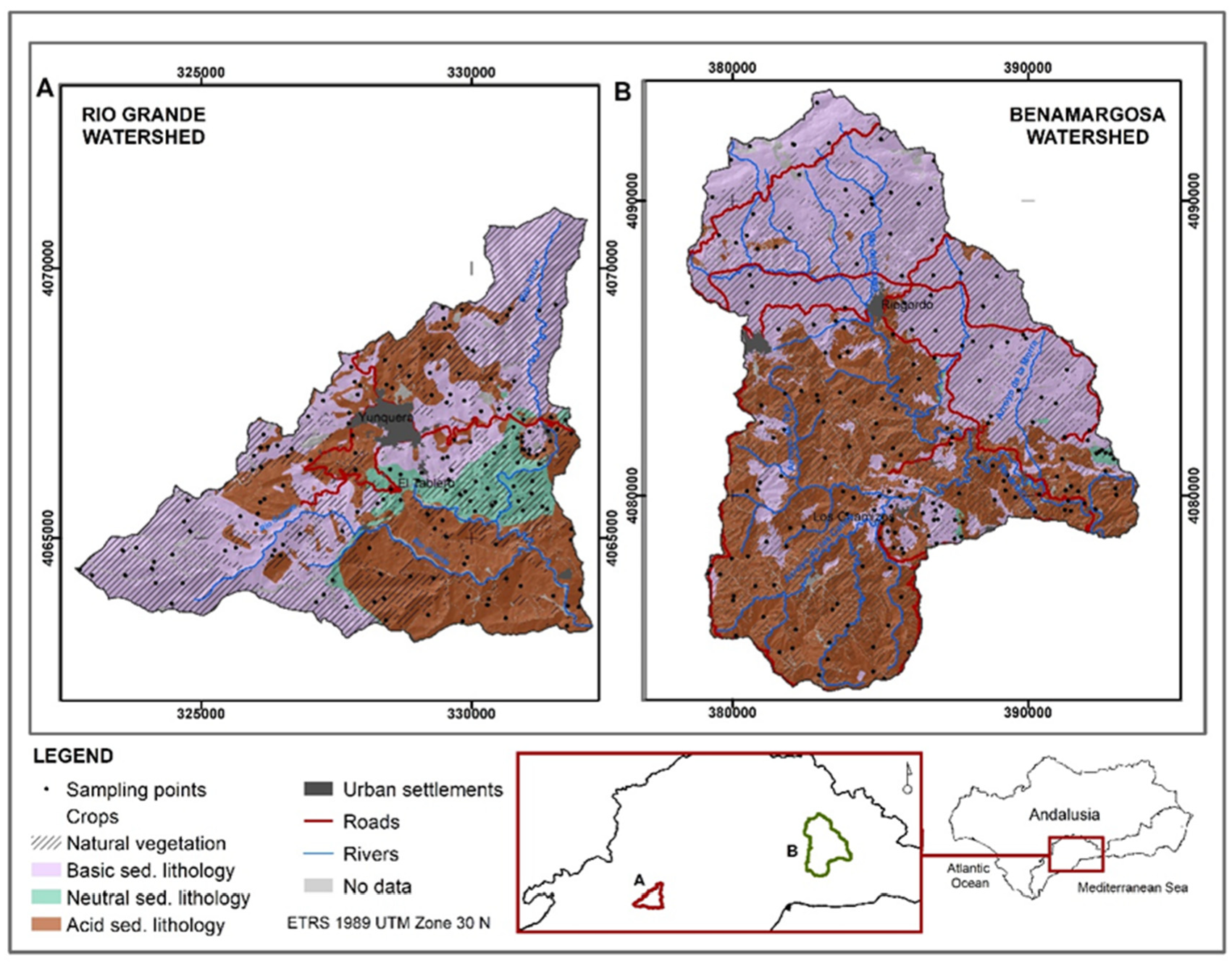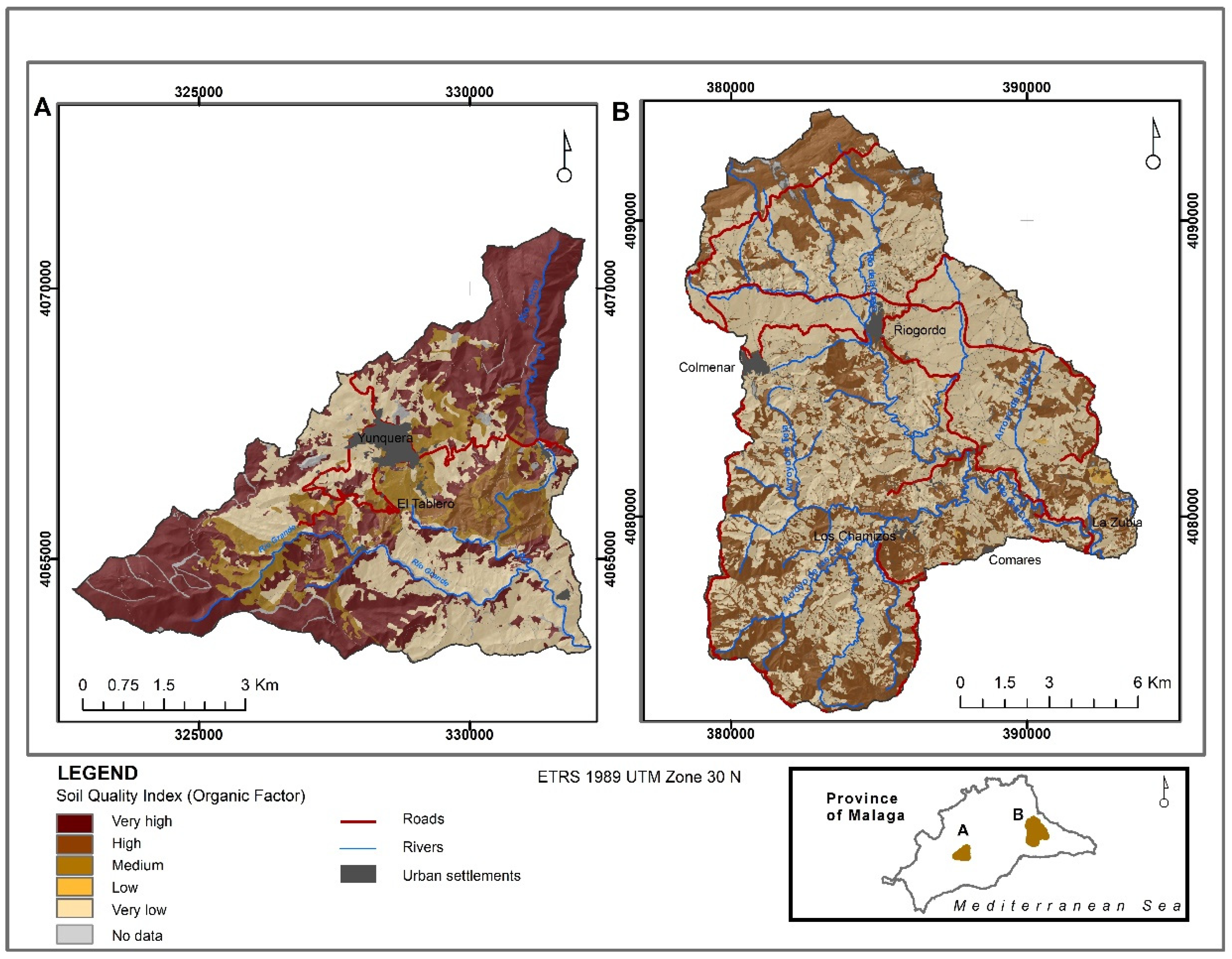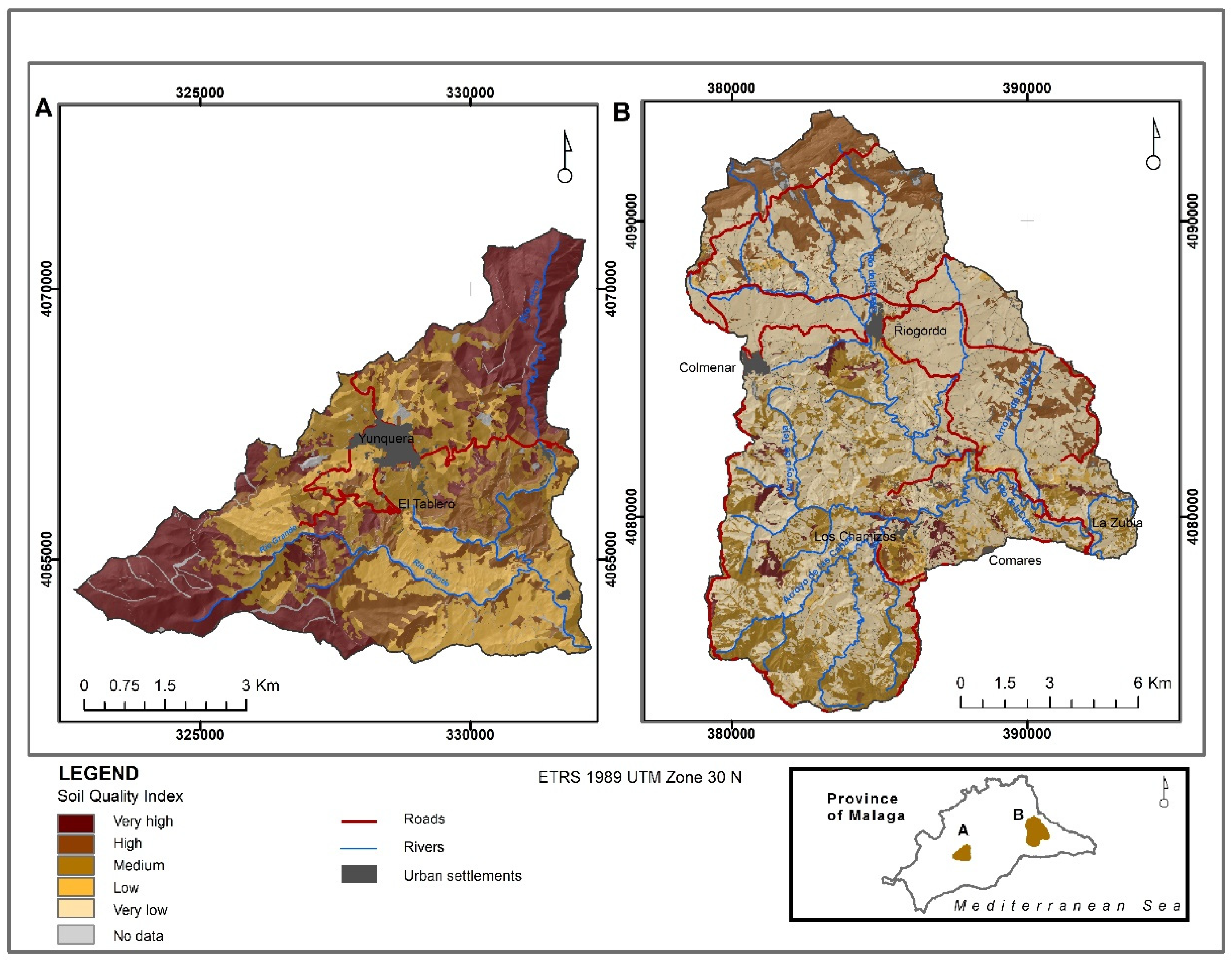Differences in the Soil Quality Index for Two Contrasting Mediterranean Landscapes in Southern Spain
Abstract
1. Introduction
2. Materials and Methods
2.1. Study Areas
2.2. Soil Sampling
2.3. Analysis of Soil Properties
2.4. Other Factors Influencing the Erosion Rate Calculated Using the RUSLE Model
2.5. Statistical Analysis
2.6. SQI Formulation
- The properties and factors used to determine the SQI were selected based on the PCA and an expert opinion system [50].
- These were reclassified on a scale of 1 to 3, with value 1 representing poor quality, 2 representing medium quality, and 3 representing high quality (Table 1). In addition, these were adjusted to both statistical criteria (quantiles) and theoretical classifications [52]. In this reclassification, the values for both watersheds were considered, to enable formulation that facilitated comparison.
- The various properties and factors were grouped into three clusters according to their characteristics (water, physical, and biological or organic), groups that would compose the final SQI, and those that could be defined as soil quality sub-indices.
- A multi-criteria evaluation was carried out individually in each group using a weighted summation (e.g. [27,28,31,34]). For this purpose, each component was given a specific weighting (priority vector), based on the experience of several experts in soil analysis [50] using a decision matrix. The Saaty method, analytical hierarchies, or peer comparison were used to assign weights. This approach is widely used in this type of study [30], and consists of elaborating a square matrix in which the number of rows and columns is defined by the number of variables to be weighted. To validate the method, the value of the consistency of judgment must be <0.1 [30]. In short, the decision matrix is an analytical hierarchy technique (AHP), through which relative weights are assigned to a group of factors in the multi-criteria assessment [27].
- The procedure was repeated to achieve the final SQI using the steps described above, but with a reclassification process based on a scale of 1 to 5 (Table 1).
2.7. Soil Quality Index (SQI)
3. Results and Discussion
4. Conclusions
Author Contributions
Funding
Acknowledgments
Conflicts of Interest
References
- Huang, J.; Yu, H.; Guan, X.; Wang, G.; Guo, R. Accelerated dryland expansion under climate change. Nat. Clim. Chang. 2016, 6, 166–171. [Google Scholar] [CrossRef]
- Reynolds, J.F.; Smith, D.M.S.; Lambin, E.F.; Turner, B.L.; Mortimore, M.; Batterbury, S.P.; Downing, T.E.; Dowlatabadi, H.; Fernandez, R.J.; Herrick, J.E.; et al. Global desertification: Building a science for dryland development. Science 2007, 316, 847–851. [Google Scholar] [CrossRef] [PubMed]
- Muñoz-Rojas, M.; Abd-Elmabod, S.K.; Zavala, L.M.; De la Rosa, D.; Jordán, A. Climate change impacts on soil organic carbon stocks of Mediterranean agricultural areas: A case study in Northern Egypt. Agric. Ecosyst. Environ. 2017, 238, 142–152. [Google Scholar] [CrossRef]
- COM. Towards a Thematic Strategy for Soil Production; Communication form the Commission to the Council, the European Parliament, the Economic and Social Committee and the Committee and the Committee of the Regions; Commission of the European Communities: Brussels, Belgium, 2002. [Google Scholar]
- Hueso-González, P.; Muñoz-Rojas, M.; Martínez-Murillo, J. The role of organic amendments in drylands restoration. Curr. Opin. Environ. Sci. Health 2018, 5, 1–6. [Google Scholar] [CrossRef]
- Eaton, J.M.; McGoff, N.M.; Byrne, K.A.; Leahy, P.; Kiely, G. Land cover change and soil organic C stocks in the Republic of Ireland 1851–2000. Clim. Chang. 2008, 91, 317–334. [Google Scholar] [CrossRef]
- Hueso-González, P.; Martínez-Murillo, J.F.; Ruiz Sinoga, J.D. Effects of topsoil treatments on afforestation in a dry-Mediterranean climate (Southern Spain). Solid Earth. 2016, 7, 1479–1489. [Google Scholar] [CrossRef]
- Jiménez, M.N.; Fernández, E.; Ripoll, M.A.; Castro, J.; Huntsinger, L.; Bruno, F. Stones and organic mulches improve the Quercus ilex L. afforestation success under Mediterranean climatic conditions. Land Degrad. Dev. 2013, 27, 357–365. [Google Scholar] [CrossRef]
- Tesfahunegn, G.B. Soil quality indicators response to land use and soil management systems in Northern Ethiopia’s Catchment. Land Degrad. Dev. 2013, 27, 438–448. [Google Scholar] [CrossRef]
- Imeson, A.C.; Vis, M. Factors influencing the aggregate stability of soils in natural and semi-natural ecosystems at different altitudes in the Central Cordillera of Colombia. Z. Für Geomorphol. 1982, 44, 94–105. [Google Scholar]
- Lavee, H.; Imeson, A.C.; Sarah, P. The impact of climate change on geomorphology and desertification along a Mediterranean arid transect. Land Degrad. Dev. 1998, 9, 407–422. [Google Scholar] [CrossRef]
- Tisdall, J.M.; Oades, J.M. Organic matter and water stable aggregates in soils. J. Soil Sci. 1982, 3, 141–163. [Google Scholar] [CrossRef]
- Lavee, H.; Imeson, A.C.; Pariente, S.; Benyamini, Y. The response of soils to simulated rainfall along a climatological gradient in an arid and semi-arid region. Catena Supp. 1991, 19, 19–37. [Google Scholar]
- Dunne, T.; Zhang, W.; Aubry, B. Effects of Rainfall, Vegetation, and Microtopography on Infiltration and Runoff. Water Resour. Res. 1991, 27, 2271–2285. [Google Scholar] [CrossRef]
- Dilly, O.; Pompili, L.; Benedetti, A. Soil micro-biological indicators separated land use practices in contrast to abiotic soil properties at the 50 km scale under summer warm Mediterranean climate in northern Italy. Ecol. Indic. 2018, 84, 298–303. [Google Scholar] [CrossRef]
- Arnold, R.W.; Szabolcs, I.; Targulian, V.O. Global Soil Change: Report of an International Institute for Applied System Analysis, International Society of Soil Science, United Nations Environmental Programme: Task Force on the Role of Soil in Global Change; International Society of Soil Science, UNEP: Laxenburg, Austria, 1990; pp. 1–110. [Google Scholar]
- Nosrati, K.; Collins, A. A soil quality index for evaluation of degradation under land use and soil erosion categories in a small mountainous catchment, Iran. J. Mt. Sci. 2019, 16, 2577–2590. [Google Scholar] [CrossRef]
- Vilček, J.; Koco, S. Integrated index of agricultural soil quality in Slovakia. J. Maps 2018, 14, 68–76. [Google Scholar] [CrossRef]
- Koellner, T.; de Baan, L.; Beck, T.; Brandão, M.; Civit, B.; Margni, M.; i Canals, L.; Saad, R.; de Souza, D.; Müller-Wenk, R. UNEP-SETAC guideline on global land use impact assessment on biodiversity and ecosystem services in LCA. Int. J. Life Cycle Assess. 2013, 18, 1188–1202. [Google Scholar] [CrossRef]
- De Andrade-Barbosa, M.; de Sousa-Ferraz, R.L.; Coutinho, E.L.M.; Coutinho-Neto, A.M.; Silveira-da Silva, M.K.; Fernandes, C.; Everlon, R. Multivariate analysis and modeling of soil quality indicators in long-term management systems. Sci. Total Environ. 2019, 657, 457–465. [Google Scholar] [CrossRef]
- Navarro, A.; Figueroa, B.; Martínez, M.; González, F.; Osuna, E.S. Indicadores físicos del suelo bajo labranza de conservación y su relación con el rendimiento de tres cultivos. Agric. Tec. Mex. 2008, 34, 151. [Google Scholar]
- SQI-Soil Quality Institute. Indicators for Soil Quality Evaluation. In USDA Natural Resources Conservation Service; The National Soil Survey Center/the Soil Quality Institute, NRCS, USDA/the National Soil Tilth Laboratory, Agricultural Research Service: Washington, DC, USA, 1996. [Google Scholar]
- Karlen, D.; Mausbach, M.; Doran, J.; Cline, R.; Harris, R.; Schuman, G. Soil quality: A concept, definition, and framework for evaluation. Soil Sci. Soc. Am. J. 1997, 61, 4–10. [Google Scholar] [CrossRef]
- Zornoza, R.; Mataix-Solera, J.; Guerrero, C.; Arcenegui, V.; García-Orenes, F.; Mataix-Beneyto, J.; Morugán, A. Evaluation of soil quality using multiple lineal regression based on physical, chemical, and biochemical properties. Sci. Total Environ. 2007, 378, 233–237. [Google Scholar] [CrossRef] [PubMed]
- Colás, A.; Cairo, P.; Machado, J.; Ruiz, Y.; Torres, P.; Dávila, A. Análisis multivariado de las propiedades de un suelo Ferralítico Rojo (Oxisol), como base para la selección de indicadores de calidad. Cent. Agric. 2008, 35, 17–24. [Google Scholar]
- Eastman, J.R. IDRISI® Selva. Guía para SIG y Procesamiento de Imágenes, Manual Versión 17; Clark University: Worcester, MA, USA, 2012. [Google Scholar]
- Joshua, J.K.; Nneoma, A.C.; Jajere, A.; Ahmed, A.J. Land suitability analysis for agricultural planning using GIS and multicriteria decision analysis approach in greater Karu urban area, Nasarawa State-Nigeria. AJAST 2013, 1, 14–23. [Google Scholar]
- Kumar, T.; Jhariya, D.C. Land quality index assessment for agricultural purpose using multi-criteria decision analysis (MCDA). Geocarto Int. 2015, 30, 822–841. [Google Scholar] [CrossRef]
- Voogd, H. Multicriteria Evaluation for Urban and Regional Planning; Pion Ltd.: London, UK, 1983. [Google Scholar]
- Gómez, M.; Barredo, J.I. Sistemas de Información Geográfica y Evaluación Multicriterio en la Ordenación del Territorio; Ra-Ma: Madrid, Spain, 2005. [Google Scholar]
- Belenguer-Plomer, M.A. Detección de problemas en la localización de usos del suelo mediante SIG y AHP: El caso de Riba-Roja de Túria (Valencia). GeoFocus 2016, 18, 3–24. [Google Scholar] [CrossRef]
- Lamelas, M.T. Esquema metodológico para la toma de decisiones sobre el uso sostenible del suelo: Aplicación a la localización de suelo industrial. GeoFocus 2009, 9, 28–66. [Google Scholar]
- Da Silva, C.J.; Cardozo, O.D. Evaluación multicriterio y Sistemas de Información Geográfica aplicados a la definición de espacios potenciales para uso del suelo residencial en Resistencia (Argentina). GeoFocus 2015, 16, 23–40. [Google Scholar]
- Ruiz-Sinoga, J.D.; Romero-Díaz, A. Soil degradation factors along a Mediterranean pluviometric gradient in Southern Spain. Geomorphology 2010, 118, 359–368. [Google Scholar] [CrossRef]
- Martínez-Murillo, J.F.; Remond, R.; Ruiz-Sinoga, J.D. Validation of RUSLE K factor using aggregate stability in contrasted mediterranean eco-geomorphological landscapes (southern Spain). Environ. Res. 2020, 183, 109160. [Google Scholar] [CrossRef]
- Marañés, A.; Sánchez, J.A.; De Haro, S.; Sánchez, S.T.; Lozano, F.J. Análisis de Suelo, Metodología e Interpretación; Servicio de Publicaciones de la Universidad de Almería: Almería, Spain, 1994. [Google Scholar]
- Guitián, F.; Carballas, T. Técnicas de Análisis de Suelos; Pico-Sacro: Santiago, Chile, 1976; ISBN 84-85170-09-1. [Google Scholar]
- Townend, J.; Reeve, M.J.; Carter, A. Water release characteristic. In Soil and Environmental Analysis, Physical Methods; Smith, K.A., Mullins, C.E., Eds.; Marcel Dekker: New York, NY, USA, 2001; Chapter 3; pp. 95–140. [Google Scholar]
- Kemper, W.D.; Rosenau, R.C. Aggregate stability and size distribution. In Methods of Soil Analysis, Part 1, 2nd ed.; Agronomy Monograph 9; Klute, A., Ed.; American Society of Agronomy: Madison, WI, USA, 1986; pp. 425–442. [Google Scholar]
- Watson, C.L.; Letey, J. Indices for characterizing soil-water repellency based upon contact angle-surface tension relationships. Soil Sci. Soc. Am. Proc. 1970, 34, 841–844. [Google Scholar] [CrossRef]
- Doerr, S.H.; Dekker, L.W.; Ritsema, C.J.; Shakesby, R.A.; Bryant, R. Water repellency of soils: The influence of ambient relative humidity. Soil Sci. Soc. Am. J. 2002, 66, 401–405. [Google Scholar] [CrossRef]
- USDA. Diagnóstico y Rehabilitación de Suelos Salinos y Sódicos; Limusa: Nuevo Leon, México, 1973; p. 172. [Google Scholar]
- Van Reeuwijk, L.P. Procedures for Soil Analysis, 6th ed.; ISRIC (International Soil Reference and Information Centre): Wageningen, The Netherlands, 2002; p. 120. [Google Scholar]
- Reynolds, W.D.; Elrick, D.E.; Youngs, E.G.; Amoozegar, A.; Booltink, H.W.G.; Bouma, J. Saturated and field-saturated water flow parameters. In Methods of Soil Analysis; Part 4 Physical Methods; Soil Science Society of America: Madison, WI, USA, 2002; pp. 797–878. [Google Scholar]
- Wischmeier, W.H.; Smith, D.D. Predicting rainfall erosion losser. In USDA Agricultural Research Service Handbook; USDA: Washington, DC, USA, 1978; p. 537. [Google Scholar]
- Reynolds, W.D.; Vieira, S.R.; Topp, G.C. An assessment of the single-head analysis for the constant head well permeameter. Can. J. Soil Sci. 1992, 72, 489–501. [Google Scholar] [CrossRef]
- Van der Knijff, J.M.; Jones, R.J.A.; Montanarella, L. Soil Erosion Risk Assessment in Europe; European Soil Bureau. Joint Research Centre: Isapra, Italy, 2000. [Google Scholar]
- Sillero-Medina, J.A.; Pérez-González, M.E.; Martínez-Murillo, J.F.; Ruiz-Sinoga, J.D. Factors affecting eco-geomorphological dynamics in two contrasting Mediterranean environments. Geomorphology 2020, 352. [Google Scholar] [CrossRef]
- Doran, J.W.; Safley, M. Defining and assessing soil health and sustainable productivity. In Biological Indicators of Soil Health; Pankhurst, C., BM Doube & VVSR Gupta, Eds.; CAB International: Wallingford, UK, 1997; pp. 1–28. [Google Scholar]
- Andrews, S.S.; Karlen, D.L.; Mitchell, J.P. A comparison of soil quality indexing methods for vegetable production systems in Northern California. Agric. Ecosyst. Environ. 2002, 90, 25–45. [Google Scholar] [CrossRef]
- IBM Corp. IBM SPSS Statistics for Windows, Version 25.0; IBM: Armonk, NY, USA, 2017. [Google Scholar]
- Cantú, M.P.; Becker, A.; Bedano, J.C.; Schiavo, H.F. Evaluación de la calidad de suelos mediante el uso de indicadores e índices. Ciencia del Suelo 2007, 25, 173–178. [Google Scholar]
- García, Y.; Ramírez, W.; Sánchez, S. Indicadores de la calidad de los suelos: Una nueva manera de evaluar este recurso. Pastos Forrajes 2012, 35, 125–138. [Google Scholar]
- Doran, J.W.; Parkin, B.T. Defining Soil Quality for a Sustainable Environment; Soil Science Society of America: Madison, WI, USA, 1994; p. 35. [Google Scholar]
- Seybold, C.A.; Mausbach, M.J.; Karlen, D.L.; Rogers, H.H. Quantification of Soil Quality. In Soil Process and the Carbon Cycle; Lal, R., Kimble, J.M., Follet, R.F., y Stewart, B.A., Eds.; CRC Press: Boca Raton, FL, USA, 1997; pp. 387–403. [Google Scholar]
- Nosrati, K. Assessing soil quality indicator under different land use and soil erosion using multivariate statistical techniques. Environ. Monit. Assess. 2013, 185, 2895–2907. [Google Scholar] [CrossRef]
- Bautista, A.; Etchevers, J.; Castillo, R.F.; Gutiérrez, C. La calidad del suelo y sus indicadores. Ecosistemas 2004, 13, 90–97. [Google Scholar]
- Labrador, J. Manejo del suelo en los sistemas agrícolas de producción ecológica. In Manual Técnico Manejo del Suelo en los Sistemas de Producción Ecológica; Sociedad Española de Agricultura Ecológica: Catarroja, Spain, 2008. [Google Scholar]
- Singer, M.J.; Ewing, S. Soil Quality. In Handbook of Soil Science; Sumner, M.E., Ed.; CRC Press: Boca Raton, FL, USA, 2000; Chapter 11; pp. 271–298. [Google Scholar]
- Gregorich, E.G.; Carter, M.R.; Angers, D.A.; Monreal, C.M.; Ellert, B.H. Towards a minimum data set to asses soil organic matter quality in agricultural soils. Can. J. Soil Sci. 1994, 74, 367–385. [Google Scholar] [CrossRef]
- Savenije, H.H.G. The importance of interception and why we should delete the term evapotranspiration from our vocabulary. Hydrol. Process. 2004, 18, 1507–1511. [Google Scholar] [CrossRef]
- Pugnaire, F.I.; Luque, M.T.; Armas, C.; Gutiérraz, L. Colonization processes in semi-arid Mediterranean old fields. J. Arid Environ. 2006, 65, 591–603. [Google Scholar] [CrossRef]
- Ruiz-Sinoga, J.D.; Martínez-Murillo, J.F. Respuesta eco-hidrológica de los suelos en campos abandonados. (Sur de España). Cuad. Investig. Geogr. 2012, 38, 31–51. [Google Scholar] [CrossRef]
- Bhat, J.A.; Kundu, M.C.; Hazra, G.C.; Santra, G.H.; Mandal, B. Rehabilitating acid soils for increasing crop productivity through low-cost liming material. Sci. Total Environ. 2010, 408, 4346–4353. [Google Scholar] [CrossRef]
- Belmonte-Serrato, F.; Ruiz-Sinoga, J.D.; Romero-Díaz, A.; Martínez-Hernández, C.; Robledano-Aymerich, F. Medida de la conductividad hidráulica mediante infiltrómetros de minidisco en suelos agrícolas cultivados y en abandono (Región de Murcia). In Espacios Insulares y de Frontera, una Visión Geográfica; Universitat de les Illes Balears: Palma de Mallorca, Spain, 2013; pp. 287–296. ISBN 978-84-616-6533-4. [Google Scholar]
- Delgado-Iniesta, M.J.; Belmonte-Serrato, F.; López-Bermúdez, F. Relaciones entre estabilidad de agregados y propiedades físicas y químicas de los suelos en un ambiente mediterráneo semiárido. Cuatern. Geomorfol. 2000, 14, 35–45. [Google Scholar]
- Pérez-Cutillas, P.; Cataldo, M.; Zema, D.A.; de Vente, J.; Boix-Fayos, C. Efectos de la revegetación a escala de cuenca sobre el caudal y la evapotranspiración en ambiente mediterráneo. Cuenca del Taibilla (SE de España). Bosque 2018, 39, 119–129. [Google Scholar] [CrossRef]
- Halifa-Marín, A.; Pérez-Cutillas, P.; Almagro, M.; Martínez-Mena, M.; Boix-Fayos, C. Dinámica geomorfológica fluvial y cambios de usos del suelo: Impacto en los reservorios de carbono de suelos y sedimentos. Bosque (Valdivia) 2019, 40, 3–16. [Google Scholar] [CrossRef]
- Pérez-González, M.E.; Sillero-Medina, J.A.; Ruiz-Sinoga, J.D. Evolución de usos del suelo y vulnerabilidad a partir de imágenes de satélite en el mediterráneo sur peninsular. XVI Coloquio Ibérico de Geografía—Península Ibérica no Mundo: Problemas e Desafíos para uma Intervençao Ativa da Geografía; SASUP: Lisboa, Portugal, 2018; pp. 1105–1113. ISBN 978-972-636-275-3. [Google Scholar]
- Sarah, P. Nonlinearity of ecogeomorphic processes along Mediterranean arid transect. Geomorphology 2004, 60, 303–317. [Google Scholar] [CrossRef]
- Lasanta, T.; Nadal-Romero, E.; Paz-Errea, J.A. The effect of landscape conservationmeasures in changing landscape patterns: A case study in Mediterranean mountains. Land Degrad. Dev. 2016, 27, 373–386. [Google Scholar] [CrossRef]






| Water Factor (1: <1.5; 2: 1.5–1.75; 3: 1.75–2; 4: 2–2.25; 5: >2.25) | |||||
| Class | PE | G | S | H | AWC |
| 1 | 0,4 | >70% | 3–20% | - | <17% |
| 2 | 0.4–0.8 | 60–70% | 20–40% | 3–4 | 17–22% |
| 3 | - | 50–60% | 40–49% | 1–2 | >22% |
| Physical Factor (1: <1.8; 2: 1.8–2; 3: 2–2.2; 4: 2.2–2.4; 5: >2.4) | |||||
| Class | Sl | K | AGS | BD | |
| 1 | >50% | >0.6 | <30% | >1.3 | |
| 2 | 40–50% | 0.3–0.6 | 30–60% | 1.2–1.3 | |
| 3 | <40% | <0.3000 | >60% | <1.2 | |
| Organic Factor (1: <1.75; 2: 1.75–2; 3: 2–2.25; 4: 2.25–2.75; 5: >2.75) | |||||
| Class | SOC | C | EC | ||
| 1 | <3% | >0.6 | >0.25 | ||
| 2 | 3–4% | 0.3–0.6 | 0.15–0.25 | ||
| 3 | >4% | <0.3 | <0.15 | ||
| Water Factor | Physical Factor | Organic Factor |
|---|---|---|
|
|
|
| Class | GR | BE |
|---|---|---|
| Very low | - | 63.33 |
| Low | 24.78 | 4.45 |
| Medium | 21.41 | 17.08 |
| High | 19.55 | 12.63 |
| Very high | 34.26 | 2.51 |
Publisher’s Note: MDPI stays neutral with regard to jurisdictional claims in published maps and institutional affiliations. |
© 2020 by the authors. Licensee MDPI, Basel, Switzerland. This article is an open access article distributed under the terms and conditions of the Creative Commons Attribution (CC BY) license (http://creativecommons.org/licenses/by/4.0/).
Share and Cite
Sillero-Medina, J.A.; Hueso-González, P.; Ruiz-Sinoga, J.D. Differences in the Soil Quality Index for Two Contrasting Mediterranean Landscapes in Southern Spain. Land 2020, 9, 405. https://doi.org/10.3390/land9110405
Sillero-Medina JA, Hueso-González P, Ruiz-Sinoga JD. Differences in the Soil Quality Index for Two Contrasting Mediterranean Landscapes in Southern Spain. Land. 2020; 9(11):405. https://doi.org/10.3390/land9110405
Chicago/Turabian StyleSillero-Medina, José A., Paloma Hueso-González, and José D. Ruiz-Sinoga. 2020. "Differences in the Soil Quality Index for Two Contrasting Mediterranean Landscapes in Southern Spain" Land 9, no. 11: 405. https://doi.org/10.3390/land9110405
APA StyleSillero-Medina, J. A., Hueso-González, P., & Ruiz-Sinoga, J. D. (2020). Differences in the Soil Quality Index for Two Contrasting Mediterranean Landscapes in Southern Spain. Land, 9(11), 405. https://doi.org/10.3390/land9110405






